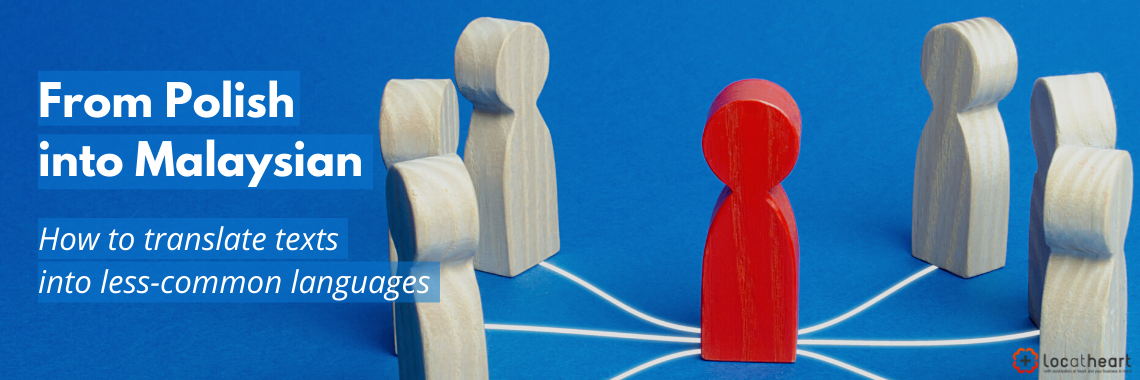From Polish into Malaysian: when to use a pivot language
What should you do when your client needs to have content translated into a language which – on a global scale – is spoken by a rather small number of people? Sometimes, finding a person to translate directly from the source text is quite difficult and even if you do find someone who is skilled enough to perform the job, there are other factors that might come into play, making it impossible to provide a satisfactory translation for us – for instance, time. In such situations, another solution comes into play – indirect translation through an intermediary language (also called a pivot language).
Everyone who works in the localisation industry speaks the jargon fluently, which is why they are more than familiar with terms such as “language pair” – meaning the language translated from and the one translated into. As part of a project, clients may require a translation into a specific set of languages which often changes dynamically, depending on the current needs.
The project might involve an EN > HU / CZ / RO / SK / PL translation (one from English into Hungarian, Czech, Romanian, Slovakian and Polish) or any other different languages. The sheer number of possible combinations indicates that in order to accomplish the task, one will have to get in touch with many subcontractors who specialise in different fields and are fluent in different languages.
And as if that was not enough, the number of language pairs does not only depend on the target language, but also the source one – not every text is written in English, after all. If the client list of a translation agency includes companies from all over the world, one can certainly expect every possible translation variation – from Portuguese into Russian, from Hungarian into Finnish, etc. In a perfect world, we would be able to work with translators who are available at any given time, speak both the languages with ease and accuracy, and catch the gist of the subject area that the text touches on; however, to no one’s surprise, those situations rarely happen. So, what can we do when we need to translate something from Polish into Malaysian, Indonesian, Icelandic, Estonian or Greek? On ProZ.com, one of the biggest translation portals, there is not one person who is a Polish–Malaysian translator. In the case of Indonesian, there are four people – of whom only one is a native speaker.
Translation through a pivot language
Fortunately, this is where the good, old (and quite obvious) English comes to the rescue. If the Polish source text is translated into today’s very universal English, it turns out that this magical portal, the very same one we have mentioned before, suddenly allows us to choose from 134 professional translators who are native speakers of Indonesian. And those are just the translators who have paid for a subscription – there are 8,138 results total. As you can see, English – whether we like it or not – is the lingua franca, and finding a translator of even the most exotic language is much easier for Shakespeare’s speech than that of Mickiewicz.
But is translation through English just a plan B? A last resort for when there are no other options? No!
Project diversity
It is definitely worth pointing out project diversity.
For some translations, such as those concerning literary works, it is advisable to translate without an intermediary language (although many books are translated through English anyway).
However, when it comes to large-scale online content projects, the situation is completely different. An example of such a project is a translation of several thousand product descriptions into over a dozen languages. It is not an artistic project, but strictly a business one, and the translation itself resembles transcreation and adaptation. Among some of the things to be included into such freshly translated content are key phrases specific to new markets.
Business aspects of indirect translation
Business aspects – such as the budget, deadline and, last but not least, coherence of the descriptions in all target languages, both on a linguistic and non-linguistic level – are crucial when it comes to this type of projects. Translation from English or into English is also the cheapest – the more popular a language is, the more people speak it, which means more competition and lower rates. Taking into account all the factors related to a given project (budget, deadlines, translators’ availability and competitive rates), it will cost us less to have the text translated twice (for instance, first from Polish into English, and then from English into Indonesian) than once by an expensive – or, in other words, rare – translator who speaks the above-mentioned language pair. A translator who might not even have enough time to squeeze us into their tight schedule because of their unique skills and workload, at that.
Using a pivot language addresses the needs of large-scale e-commerce localisation
At locatheart, we base many multilingual projects on such a system. We will talk about our processes in more detail in our next blog article. We will also discuss all the aspects that ought to be taken into consideration when deciding on such a project so that your translations from translations do not turn into a game of Chinese whispers.
If you are ever in need of a translation through an intermediary language or you are wondering if this is the right the solution for you, feel free to contact us!






Leave a Reply